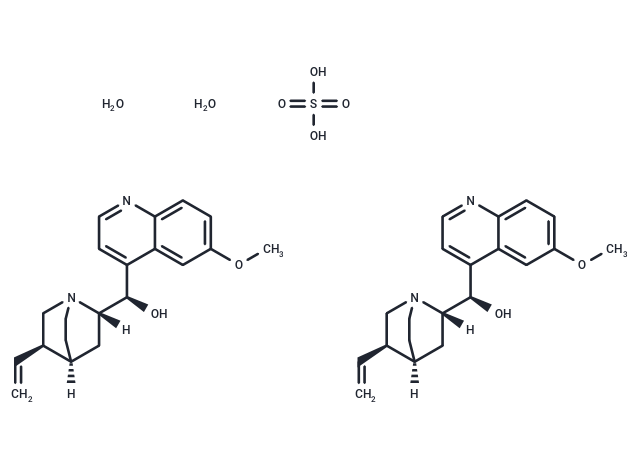Shopping Cart
- Remove All
 Your shopping cart is currently empty
Your shopping cart is currently empty

Quinine sulfate dihydrate plays a major role in potassium channel blockers. It is also used as an antimalarial, anticholinergic, antihypertensive and a hypoglycemic agent. It inhibits mitochondrial ATP-regulated potassium channel. It is also used to study the metabolism of biocrystalized heme, hemozoin, in malarial parasites and to study the toxicity of heme (FP)-complexes.

| Pack Size | Price | Availability | Quantity |
|---|---|---|---|
| 10 g | $29 | In Stock |
| Description | Quinine sulfate dihydrate plays a major role in potassium channel blockers. It is also used as an antimalarial, anticholinergic, antihypertensive and a hypoglycemic agent. It inhibits mitochondrial ATP-regulated potassium channel. It is also used to study the metabolism of biocrystalized heme, hemozoin, in malarial parasites and to study the toxicity of heme (FP)-complexes. |
| Targets&IC50 | P. falciparum (60 Thai isolates):10 to 500 nM (MIC) |
| In vitro | Quinine is an alkaloid antimalarial agent that has MIC values ranging from 10 to 500 nM for 60 Thai isolates of P. falciparum. It inhibits hemozoin formation in purified trophozoites, leading to an increase in free heme, similar to the mechanism of action of chloroquine[1]. |
| In vivo | In mice, quinine reduces P. berghei parasite load in the blood with a minimum effective dose (MED) of 150 mg/kg [2]. |
| Molecular Weight | 818.97 |
| Formula | C40H58N4O12S |
| Cas No. | 6119-70-6 |
| Smiles | O.O.OS(O)(=O)=O.[H][C@@]12CCN(C[C@@H]1C=C)[C@@]([H])(C2)[C@H](O)c1ccnc2ccc(OC)cc12.[H][C@@]12CCN(C[C@@H]1C=C)[C@@]([H])(C2)[C@H](O)c1ccnc2ccc(OC)cc12 |
| Relative Density. | no data available |
| Storage | keep away from direct sunlight | Powder: -20°C for 3 years | In solvent: -80°C for 1 year | Shipping with blue ice. | ||||||||||||||||||||
| Solubility Information | DMSO: 8.19 mg/mL (10 mM), Sonication is recommended. | ||||||||||||||||||||
Solution Preparation Table | |||||||||||||||||||||
DMSO
| |||||||||||||||||||||

Copyright © 2015-2025 TargetMol Chemicals Inc. All Rights Reserved.